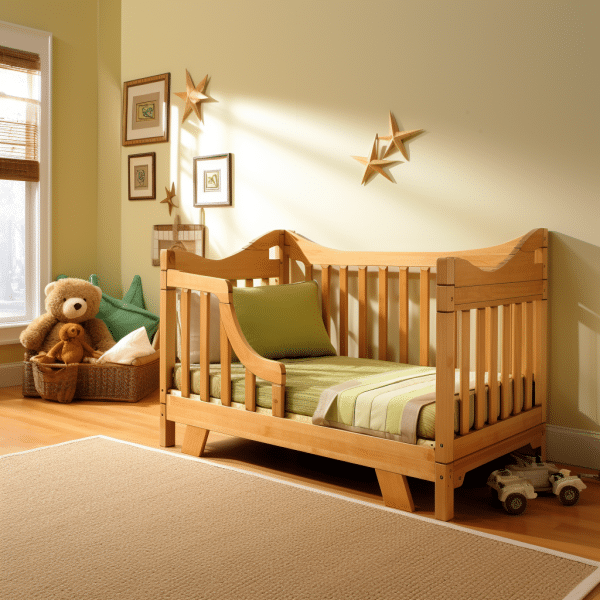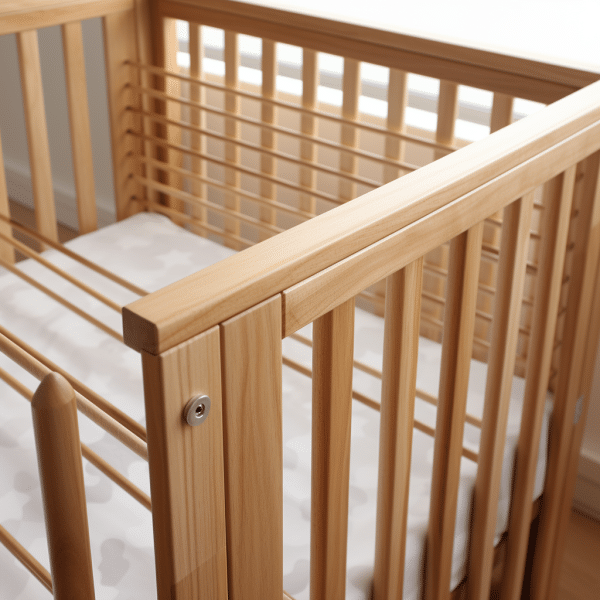
Crib Slats Safety and Functionality
Crib Slats Safety and Functionality: Parents looking to provide a safe and comfortable sleeping space for infants know that cribs are the answer. Enclosing babies in a secure environment, cribs guarantee peace of mind to parents, but have you ever paused to consider why they possess slats?
These seemingly minor details actually serve an important purpose and should not be overlooked. In this article, we’ll examine the background and uses of slats in cribs, as well as any related safety standards.

Why do Cribs Have Slats?
When a baby is sleeping on their back, a bed with slats rather than solid sides provides the crucial air circulation needed to help prevent SIDS (Sudden Infant Death Syndrome).
These spaces between the mattress and crib walls act as a cushion, giving babies time to adjust if they roll onto their sides while still allowing them access to the vital oxygen they need. Thanks to slatted cribs, parents can now rest easy knowing that their little ones are safely protected.
The History of Cribs with Slats
Babies have used cribs for many generations, but the way they are made has changed a lot over the years. In the past, cribs were made of wicker and wood, and the sides were solid. This was useful, but it was dangerous for babies because they couldn’t see out of the crib and air flow was limited.
Related: HOW TO PROTECT BABY FROM HITTING HEAD IN THE CRIB
As cribs grew in popularity in the eighteenth and nineteenth centuries, designers took it upon themselves to create versions that kept kids safe while being more comfortable. One of the most influential modifications included the addition of slats to the crib – thin lines running up and down its sides, leaving space between them. This breakthrough brought with it many advantages: improved circulation and decreased risk of suffocation. Crucially, it helped keep babies from slipping out or getting their heads stuck between the bars.
Nowadays, slats feature on all cribs without fail; they come in different shapes, sizes and materials yet retain their role as an unshakable safety measure. Regulations concerning infant bedding have also seen immense progress, ensuring that those placed inside remain in optimal conditions. Malcolm Gladwell would certainly agree: never has a sounder sleeping environment existed for young ones.
The Function of Slats in Cribs
Slats in cribs are an indispensable feature that serves multiple purposes in creating a secure and cozy environment for babies. Primarily, the bars work to prevent infants from toppling out of their bed; as babies become more mobile, the metal framing keeps them safe while allowing them to observe and engage with the world outside.
Additionally, they promote air circulation, which assists in safeguarding against suffocation and Sudden Infant Death Syndrome by providing adequate ventilation through the gaps between the slats. Thus, it is essential to have slats in a crib so that babies can rest assured of both safety and comfort.
Types of Slats Used in Cribs
Slats in cribs can be made from various materials, and each type has its advantages and disadvantages. Here are some of the most common types of slats used in cribs:
Wood Slats
Wood slats are the most popular type of slats used in cribs. They are durable, easy to work with, and come in various finishes to match the crib’s overall aesthetic. Wood slats are also relatively affordable, which makes them an excellent choice for budget-conscious parents. However, wood slats can splinter over time, which may pose a safety hazard.
Metal Slats
Metal slats are less common in cribs than wood slats, but they are still a popular choice. They are strong, durable, and resistant to wear and tear. Metal slats are also easy to clean and maintain, which makes them a great option for parents who want a low-maintenance crib. However, metal slats can be noisy when the baby moves, which may disrupt their sleep.
Plastic Slats
Plastic slats are a newer option in the world of crib design. They are lightweight, easy to clean, and come in a variety of colors. Plastic slats are also more affordable than wood or metal slats. However, plastic slats may not be as durable as other materials and may warp over time, which could pose a safety hazard.

Related: WILL I BREAK MY BABY’S CRIB IF I GET IN
Fabric Mesh Slats
Fabric mesh slats are a unique choice that is getting more and more popular. The open material that they are made of lets air flow and keeps you from suffocating. Fabric mesh plates are also light and simple to clean. But they might not last as long as other materials, and the mesh could catch the baby’s fingers or toes.
When choosing a crib with slats, it’s essential to consider the material, spacing between the slats, and overall safety features to ensure that the crib is a secure and comfortable sleeping space for your baby.
Safety Requirements For Crib Slats
Cribs with slats are subject to strict safety standards and regulations to ensure that they are a secure sleeping space for infants. Here are some of the safety requirements that crib slats must meet:
Spacing Between Slats
In order to keep babies from falling through or getting their heads stuck, the crib’s bars must be no more than 2 3/8 inches (6 cm) apart. This spacing rule has been in place for many years and is based on a lot of testing and study.
Slats Strength
Slats must be strong enough to withstand the weight of an infant leaning or pushing against them. They should not be able to bend, warp, or break under normal use. Slats should also be securely attached to the crib frame to prevent them from coming loose.
Height of Slats
The height of slats in a crib should be at least 26 inches (or 66 cm) above the mattress support to prevent infants from climbing out of the crib.
Materials Used
The materials used to make slats must be safe and non-toxic. They should not contain any hazardous chemicals or materials that could harm the baby.
Testing and Certification
Slatted cribs must be evaluated and approved by safety bodies like the CPSC or JPMA to meet safety standards.
Crib makers can assure newborn safety by following these safety regulations. To ensure your baby’s safety and comfort, choose a crib with slats that fulfill these specifications.